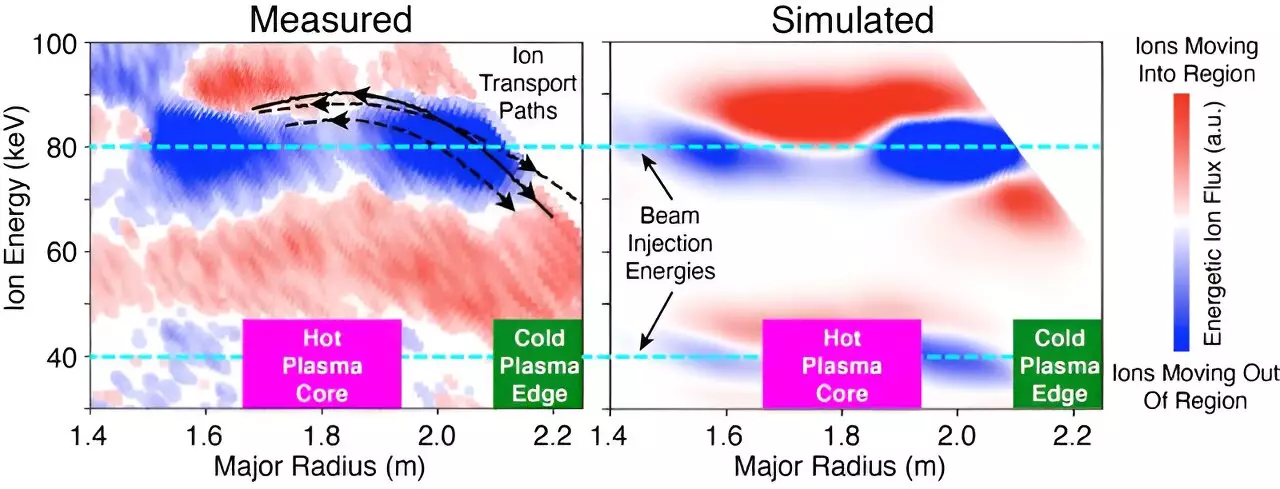In the pursuit of energy production, maintaining confinement of fusion-produced energetic ions is crucial in a burning plasma. However, the presence of electromagnetic waves in fusion plasmas can disrupt this confinement, leading to a decline in plasma heating and the termination of the burning plasma state. In a recent study conducted at the DIII-D National Fusion Facility, researchers have made significant strides in understanding the dynamics between plasma waves and energetic ions by directly observing their movement in a tokamak. By combining these observations with advanced computer models, they have improved our understanding of the interplay between these two crucial components in fusion plasmas.
As plasma physics and fusion research progress towards the development of demonstration power plant designs, accurate simulations and predictive tools become indispensable. To ensure the success of this transition, researchers require comprehensive simulations that can accurately predict the performance of power plant designs. While most current facilities do not generate burning plasmas, researchers have a solid grasp of the underlying physics and are working towards replicating observed experimental behavior through simulations. The recent research at the DIII-D tokamak has provided new measurements of energetic ion flow, which will significantly contribute to the development of models that incorporate all wave-ion interaction dynamics.
Phase-Space Engineering for Fusion Plasma Design
The enhanced understanding of plasma waves and energetic ions facilitates the application of phase-space engineering. This process empowers researchers to design new fusion plasma scenarios based on predicted ideal interactions between waves and ions. Furthermore, this newfound knowledge is not only beneficial for fusion research but also holds potential in the improvement of satellite reliability. Interactions similar to those observed in fusion plasmas can impair satellites, causing malfunctions. By gaining a deeper understanding of wave-particle interactions, fusion plasma research contributes to simulations of outer space plasmas, thereby enhancing the reliability of future satellite missions.
Researchers at the DIII-D National Fusion Facility have utilized the Imaging Neutral Particle Analyzer (INPA) to measure the energetic ion flow in a tokamak. This diagnostic system marks a significant milestone after years of conceptualization, design, and construction. By employing the INPA, researchers were able to observe the behavior of energetic ions as they interacted with electromagnetic plasma waves and traversed the tokamak in terms of energy and position. The simulations conducted as part of this study successfully replicated the observed behavior, validating the accuracy of first-principles models in describing the underlying physics.
Unveiling the Detailed Interplay
The combination of the INPA measurements and advanced high-performance computing simulations has provided researchers with the most detailed understanding to date of the interplay between plasma waves and energetic ions in fusion plasmas. By analyzing the energy of neutral beam-injected energetic ions across time and spatial position, from the hot plasma core to the cold plasma edge, researchers have gained invaluable insights into the dynamics of these interactions. This comprehensive understanding lays the foundation for applying phase-space engineering, enabling the design of fusion plasma scenarios that optimize the ideal interactions between waves and ions.
Implications for Outer Space Plasma
Beyond its implications for fusion power plant design, this research also contributes to our understanding of plasmas observed in outer space. For instance, electromagnetic ion cyclotron (EMIC) waves cause electrons to flow through space and energy, occasionally leading to electron acceleration and satellite malfunctions. Building on the fundamental understanding of wave-particle resonant interaction processes gained through fusion plasma research, simulations of outer space plasma can be improved, ultimately enhancing the reliability of future satellite missions.
The recent measurements and simulations conducted at the DIII-D National Fusion Facility have significantly advanced our understanding of the interplay between plasma waves and energetic ions in fusion plasmas. Through the use of the INPA diagnostic system, researchers were able to directly observe the behavior of energetic ions as they interacted with electromagnetic plasma waves. This improved understanding facilitates the application of phase-space engineering and has implications not only for fusion power plant design but also for enhancing the reliability of satellite missions. As plasma physics and fusion research delve deeper into the realm of demonstration power plant designs, accurate simulations and comprehensive predictive tools become paramount. With each new study, we move closer towards unlocking the potential of fusion energy and advancing our understanding of plasma dynamics both on Earth and in outer space.


Leave a Reply